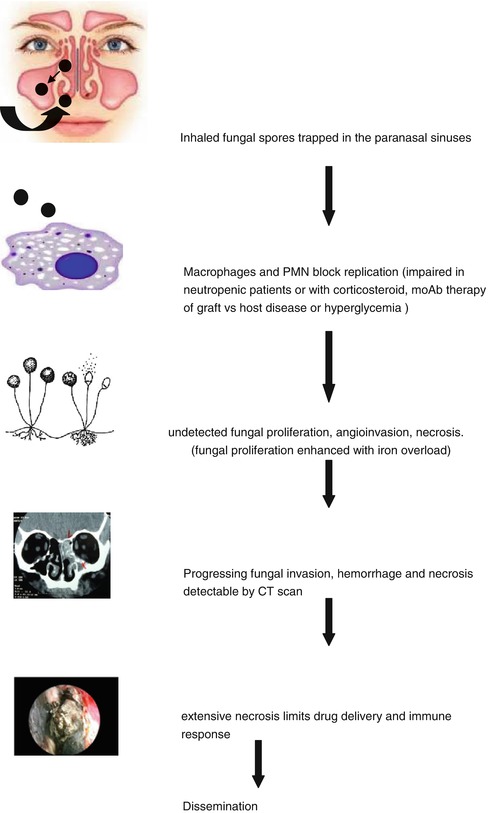Fig. 1
Risk factors for invasive fungal sinusitis – many of them are interrelated
Documented mucormycosis is at least five to ten times less common as compared to other mold infections such as Aspergillosis, making it difficult for inexperienced personnel to identify the infection early [3]. As the pathophysiology, mode of acquisition, and underlying patient risk factors for mucormycosis are similar to aspergillosis, clinical distinction between the two entities is difficult [36]. Both infections are acquired primarily through inhalation of fungal spores, which are ubiquitous in the environment, leading to sinopulmonary disease [37–39] (Fig. 2). However, some scenarios, risk factors, and elements of clinical and radiological features could prompt to a high index of suspicion for incipient mucormycosis [18, 35] (Table 1).


Fig. 2
Pathophysiology of invasive fungal sinusitis (Based on Pathophysiology of invasive pulmonary mucormycosis: Kontoyiannis and Lewis [36])
Clues | Comments |
|---|---|
Epidemiology and host clues | |
Institution with high rates of mucormycosis | Unique geographic exposures vs. institution-specific differences in immunosuppression and anti-infective practices |
Iron overload | Most reliable method of diagnosis unclear |
Hyperglycemia with or without diabetes mellitus | Degree and duration undefined |
Prior voriconazole or echinocandin use | The magnitude and specificity of such association are debatable |
Clinical, radiologic, and laboratory clues | |
Community-acquired sinusitis | Pansinusitis or ethmoid involvement are important clinical clues of mucormycosis |
Oral or necrotic lesions on hard palate or turbinates | |
Chest wall cellulitis adjacent to lung infarct | Mucormycosis can spread across tissue planes |
Acute vascular event (e.g., myocardial infarct, GI bleeding) | Resulting from acute hemorrhagic infarct caused by Mucorales |
Reverse halo sign on CXR or CT | Halo sign is as common in invasive pulmonary mucor as in invasive pulmonary aspergillosis |
Presumed (by CT findings) fungal pneumonia with adequate voriconazole levels | |
Presumed (by CT findings) fungal pneumonia with repetitively negative galactomannan and G-glucan serum levels |
References
1.
Veress B, Malik OA, Tayeb AA, El Daoud S, El Mahgoub S, El Hassan AM. Further observations on the primary paranasal Aspergillus granuloma in Sudan. Am J Trop Med Hyg. 1973;22:765–72.PubMed
2.
Chakrabarti A, Sharma SC. Paranasal sinus mycoses. Indian J Chest Dis Allied Sci. 2000;42:293–304.PubMed
3.
Chamilos G, Luna M, Lewis RE, et al. Invasive fungal infections in patients with hematologic malignancies in a tertiary care cancer center: an autopsy study over a 15 year period (1989–2003). Haematologica. 2006;91(7):986–9.PubMed
4.
5.
6.
7.
Chakrabarti A, Sharma SC, Chander J. Epidemiology and pathogenesis of paranasal sinus mycoses. Otolaryngol Head Neck Surg. 1992;107:745–50.PubMed
8.
Prabhu RM, Patel R. Mucormycosis and entomophthoramycosis: a review of the clinical manifestations, diagnosis and treatment. Clin Microbiol Infect. 2004;10 Suppl 1:31–47.PubMedCrossRef
Stay updated, free articles. Join our Telegram channel

Full access? Get Clinical Tree


